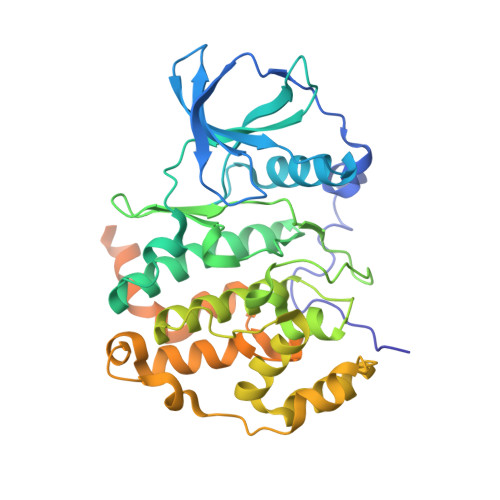Competition between electrostatic interactions and halogen bonding in the protein-ligand system: structural and thermodynamic studies of 5,6-dibromobenzotriazole-hCK2 alpha complexes.
Winiewska-Szajewska, M., Czapinska, H., Kaus-Drobek, M., Fricke, A., Mieczkowska, K., Dadlez, M., Bochtler, M., Poznanski, J.(2022) Sci Rep 12: 18964-18964
- PubMed: 36347916
- DOI: https://doi.org/10.1038/s41598-022-23611-0
- Primary Citation of Related Structures:
7QGB, 7QGC, 7QGD, 7QGE - PubMed Abstract:
CK2 is a member of the CMGC group of eukaryotic protein kinases and a cancer drug target. It can be efficiently inhibited by halogenated benzotriazoles and benzimidazoles. Depending on the scaffold, substitution pattern, and pH, these compounds are either neutral or anionic. Their binding poses are dictated by a hydrophobic effect (desolvation) and a tug of war between a salt bridge/hydrogen bond (to K68) and halogen bonding (to E114 and V116 backbone oxygens). Here, we test the idea that binding poses might be controllable by pH for ligands with near-neutral pK a , using the conditionally anionic 5,6-DBBt and constitutively anionic TBBt as our models. We characterize the binding by low-volume Differential Scanning Fluorimetry (nanoDSF), Isothermal Calorimetry (ITC), Hydrogen/Deuterium eXchange (HDX), and X-ray crystallography (MX). The data indicate that the ligand pose away from the hinge dominates for the entire tested pH range (5.5-8.5). The insensitivity of the binding mode to pH is attributed to the perturbation of ligand pK a upon binding that keeps it anionic in the ligand binding pocket at all tested pH values. However, a minor population of the ligand, detectable only by HDX, shifts towards the hinge in acidic conditions. Our findings demonstrate that electrostatic (ionic) interactions predominate over halogen bonding.
Organizational Affiliation:
Institute of Biochemistry and Biophysics PAS, Pawinskiego 5a, 02-106, Warsaw, Poland. [email protected].















